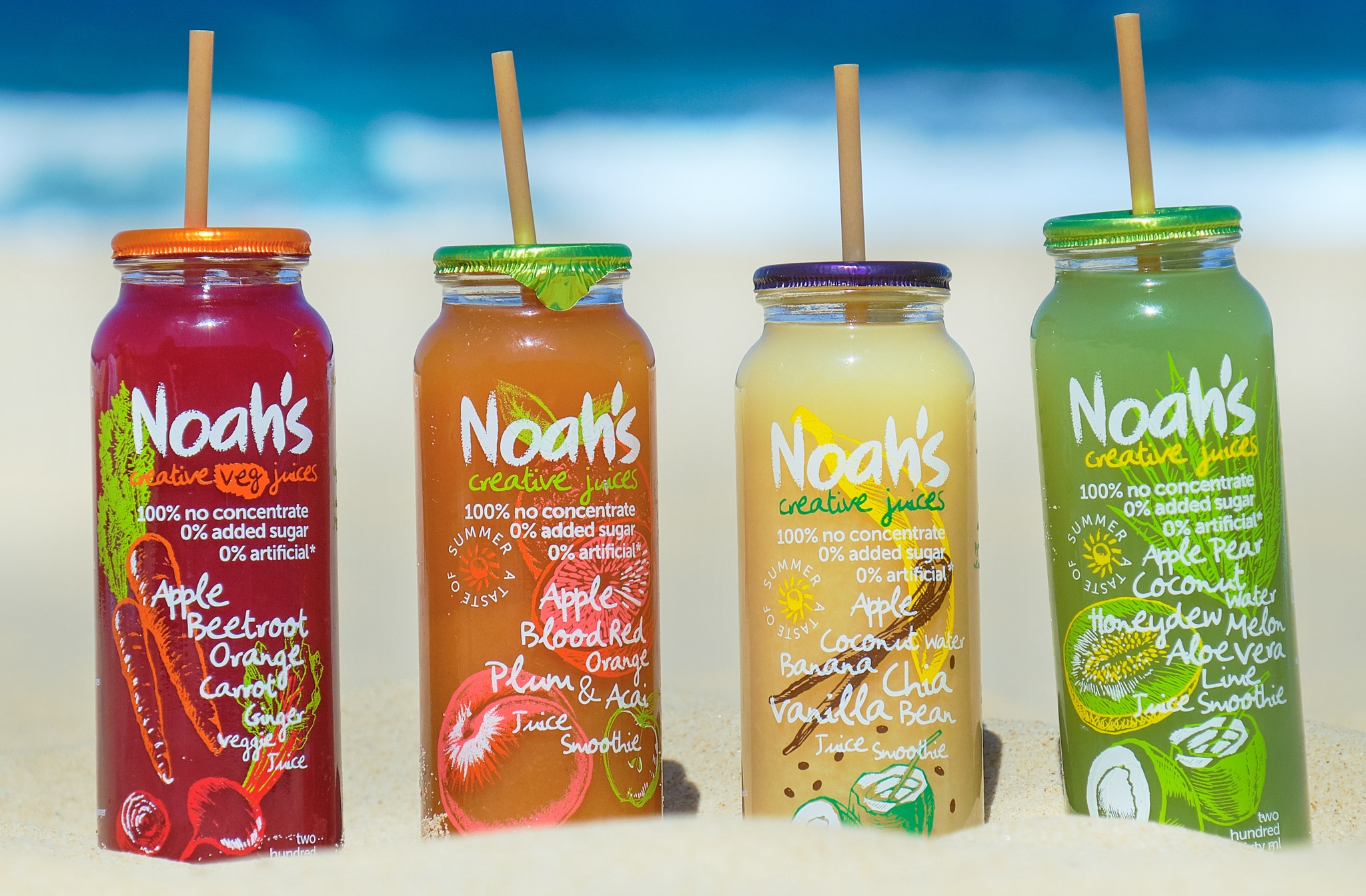How does a glass bottle with some recycled content help the environment?
From the very inception of Noah’s creative juices we made sure we chose packaging that was kinder on the environment. We bottle our range in glass with about 30% recycled content, our lids are a simple, slim aluminium foil (so there’s less material being used and shipped around), our labels are made from glass particles that fuse with the bottle removing the need for a separate label.
Last, but not least, Noah’s creative juices have replaced plastic straws completely with non-plastic straws creatively made from cane sugar fibre.
It wasn’t easy but it was one of the best decisions we, as a business, have made. We could keep following the pack and carry on doing the same as many other juice brands but have made the decision to find a happy medium between keeping the people who love our juices happy (or making them happier), while also making better choices for our environment.
Noah’s creative juices
Come in a glass bottle (made with about 30% recycled glass)
Are capped with a unique foil lid (which uses less material than most options for caps)
There is no need for a plastic label because we use ink made from glass particles that fuses with the bottle removing the need for a separate label
Offered with a non-plastic straw made from cane sugar fibre.
So overall a much softer footprint and a great alternative to plastic lid, plastic bottle, plastic straw and plastic label, wouldn’t you agree?
Now you have a little bit of the information behind our packaging we can now get onto answering the question, how does recycled glass help the environment?
Does recycling your glass bottles help the environment?
Yes, it does.
When using a portion of recycled glass (rather than making glass from scratch), it creates quite a few benefits to the environment, these are listed below for you now.
Sustainable resource if everyone continues to recycle their glass
Conserves resources by using a renewable resource for manufacturing rather than calling entirely on new resources to fill quotas
Environmentally friendlier because the stress on landfill is less due to less glass being dumped.
You can happily recycle your old jars, glass containers, bottles, Noah’s creative juice bottles and other similar glass vessels and know that they potentially are heading to a place where they will be cleaned, sorted, crushed and then prepared to be mixed with other materials to make new recycled glass products.
But, a word of caution before you go throwing all of your glass into the recycle bin, there are some glass variations that shouldn’t be recycled as they have had other impurities added to serve different purposes.
Items like lightbulbs, some cookware, china, coloured drinking glasses, ceramics like Pyrex, table tops and most window panes have other substances added to them and if they are then added to the recyclable glass you have the risk of contaminating the whole batch.
What’s the glass recycling process?
As explained quickly above, the process for recycling glass starts with you pulling a Noah’s creative juice or smoothie out of the fridge, walking to the counter, handing over your hard-earned money, maybe piercing the lid with your straw before heading out into the world and then sipping on it until finished.
You then deposit the bottle into the local glass recycling rubbish bin and then this glass bottle, along with all of its friends, head off to a recycling centre.
The glass containers are then cleaned thoroughly and separated into the different colours, which in this day and age is really only three colours, clear (not really a colour, but you know what we mean), amber and green. This separation of colours occurs because each of the colours have a different composition of materials used to make it.
The different coloured glass is then crushed into much smaller pieces ready for the next part of the process which is the melting down of the glass. When your glass gets recycled this becomes a portion that goes into the creation of new glass bottles. Recycled glass is mixed as an input into new glass bottles.
Then finally, as the glass is liquid by this stage it is given a new shape, so either a bottle or a jar.
Then they cool and are shipped off to their next owner or user throughout the manufacturing world.
If they happen to be a juice bottle again they are cleaned, filled labelled and put on a delivery truck to be stocked back into the fridge again at your local cafe ready to start the process again.
Easy huh?
Well not for some, the hardest part of the process is getting the glass bottle into the right recycle bin so it can start its journey.
But that’s where you come in.
Where to from here for Noah’s creative juices?
We have only just started with the introduction of our non-plastic straw and there is more for us to do on the horizon too.
We want to create more information to help raise awareness about recycling and to help you understand about the problems that not only we face, but the whole world faces in regards to waste, especially plastic waste.
Every little bit helps and with the anti-plastic sentiment growing in Australia around plastic bottles, plastic bags and plastic straws there needs to be changes made.
So the mission for us all is to simply start to make choices that are kinder on the environment.
And if your choice involves choosing one of our juices to start your softer footprint journey, that’s good enough for us and certainly as good a place as any to begin your own journey.


